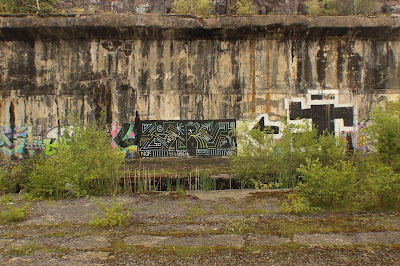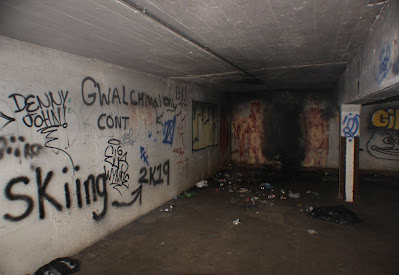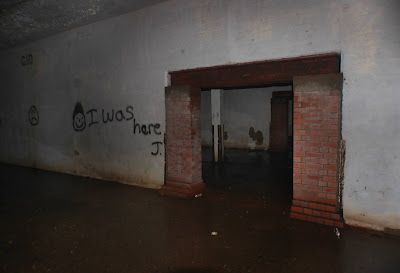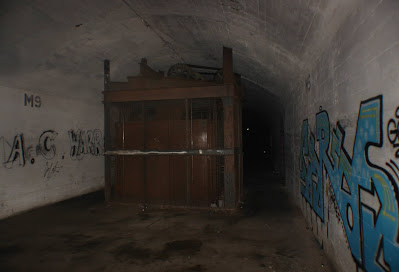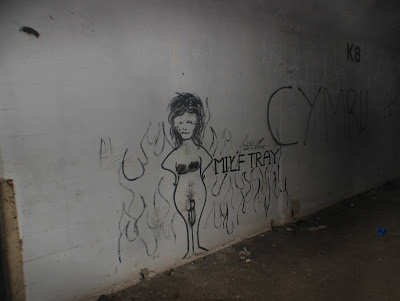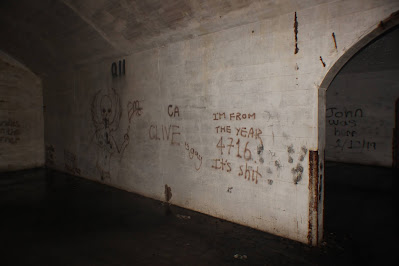(Disclaimer: Joking aside, I fully understand the risks/dangers involved in these adventures and do so in the full knowledge of what could happen. I don't encourage or condone and I accept no responsibility for anyone else following in my footsteps. Under UK law, trespass without force is a civil offence. I never break into a place, I never photograph a place that is currently occupied, as this would be morally wrong and intrusive, I never take any items and I never cause any damage, as such no criminal offences have been committed in the making of this blog. I will not disclose location or means of entry. I leave the building as I find it and only enter to take photographs for my own pleasure and to document the building.
This is probably one of my favourite places ever. It's got a cool history, it's underground, it's gigantic, it's about as safe as letting Kate McCann babysit your kids, and the archways protruding from the landscape are slightly reminscent of the Autobots headquarters in the old Transformers cartoon. What more could I ask for?
Basically what we're looking at here is a giant wartime bomb storage facility.
At the far end of this big rectangular pit, the surrounding slate was sloped sufficiently to allow access, although this hasn't always been the case. Look closely and you'll be able to see the original access tunnels. All of this was once underground. Rewind to 1941, and one would be walking across a relatively flat expanse, unaware of what was going on underfoot. Skip ahead to 1942 and one would want to stand clear because the roof came crashing down. Oops. From up here, it's still possible to see the lines across the floor that would have been different storage bay areas.
There's my accomplice Jess down below to give some indication of size. (Jess is ordinary human size, and not a borrower.)
I'll start with the "official" entry tunnels.
This was apparently a standard-guage railway line. For those who don't know, standard-guage is trainglish for your typical railway line. This would have been the main entrance.
This tunnel just curves around before it's eventually blocked off.
Check out the ceiling though. These white things are minature stalactites. Water droplets have seeped through and the minerals contained in them have dried into these little bumps. That's quite cool.
Some guy called Tom has tried to sign every rock for some reason.
From what I understand, after the ceiling collapsed on this now outdoor area, the remaining underground portion was bricked off. But that's not to say there isn't a way in.
The second door was wide open, and anyone could just stroll on in. As you can see, there are some old train buffers here to stop trains from proceeding any further. Prior to the collapse in 1942, the yellow wall wasn't there, nor were the buffers, and the trains would just roll right on in. Following the collapse, and the subsequent clear out of all the debris, the buffers were installed so that trains stopped here, using the now-outdoor area for open storage.
Let's slip inside!
In the early 1940s, the trains would have stopped here and folks would be hard at work unloading bombs and carting them off to whatever storage bay they needed to go into. This place is huge, too. Much, much bigger than I was expecting.
The little area where the train pulled in is now flooded, but there's steps down to it if anyone fancies a paddle. I don't particularly fancy that. It's pretty stagnant. I could still hear running water somewhere in here though, and the echo made it thunder around magnificently.
Originally the whole area was once a quarry consisting of numerous pits connected by underground narrow-guage railway tunnels. It opened up in the 1870s and was at the time the largest quarry in the area. In 1883 it had a workforce of 70 men, but by 1898, the workforce had exploded to 273.
It's historic significance to the mining industry came in 1869, when two carts of nitroglycerine exploded on route to the quarry, only a few miles away. It was said at the time to be the largest man-made explosion in history, with the media reporting that it could be felt 38km away. I'm not sure what the media was like in 1869, but it was probably better than the mainstream media of today. But then, so is syphilis.
This is just standard wall scrawling. I've seen "Look behind you" so many times, along with weird obsessions with misfortunes falling on ones grandmother. It'a not original. But we're still by the entrance. People with unoriginal thoughts won't be the ones venturing in deep.
Here's some art, next to your standard pentagram, and a not-so-standard swastika. Someone fucked that up, didn't they? Amateur fascists. Hitler was a twat but at least he got his twattery right.
The workforce of the quarry dwindled in the new century and by the time it closed in 1930, only two men were on the payroll. The glory days were over.
Here, scrawled on the support pillar, is a little pencil doodle of a woman spreading her legs. This was probably done by one of the folks who worked here in the 1940s. I don't know for sure, but some other pencil doodles around here did have a date on it, and I've seen this sort of thing in underground military facilities before. It's human nature to express oneself.
Paranormal enthusiasts will be disappointed to know that any fog in these pictures is actually my breathe. It was pretty chilly down here, and I found myself having to take multiple shots just to get one where my own exhalations weren't visible.
While the pillars are original, it's thought that the brickwork was added after the collapse of 1942 to prevent any further collapses. This is why the brickwork obscures a view of the bay number on the wall there. The bay number simply wasn't important anymore. The brickwork doesn't quite reach the ceiling, which is interesting. It's probably reinforcing the wall.
The local kids have used the opportunity to scrawl on the ceiling.
The 1942 collapsed was pretty catastrophic. It was eventually attributed to pressure from the government to accelerate and cheapen the cost of construction. As always, cutting corners for short term profit, but with long term disastrous ramifications. People never learn.
Apparently cracks had been
observed in the support beams and ceiling prior to the facility opening,
but these were put down to minor defects instead of faulty design.
Unfortunately they were actually in the middle of unloading a train when
the ceiling came crashing down, and 27 carriages were crushed.
Surprisingly, I can't find any mention of people dying in the collapse,
but it seems difficult to believe that nobody did. However, the collapse cut off the rest of the
facility from the main entrance. No trains could enter and therefore the
RAF were cut off from what was estimated to be about 14% of their total
stock. That's a little inconvenient during a world war. Luckily no bombs went off in the collapse. It was disastrous, but not nearly as bad as it could have been.
Over the
next nine months, most of the bombs were safely recovered and the debris
cleared out, but the part of the facility that was still underground,
that we're currently scurrying around, was considered unsafe and never
used for bomb storage again. They bricked it up and abandoned it.
As you can see, the majority of the graffiti is still more "I just got back from the Jeremy Kyle show" than actual art. It's a shame. This place would look spectacular if the walls were covered by real artwork.
The acoustics in here are pretty amazing. Every minor sound has a powerful echo. One thing I noticed for the first time, but have noticed ever since, is that Jess sings to herself really quietly while she explores. In regular locations, it's barely audible unless one stands right next to her and listens carefully, but here I was underground, and I was hearing singing coming from every direction. I said to Jess numerous times "Someones in here singing." She just thought I was bonkers. With her, it's subconscious and habitual, so even she didn't realise that she was the culprit. It made for some comical confusion.
Thankfully it wasn't all just spacious abandoned storage down here, but there were also two awesome 1940s elevators. I wasn't aware prior to the adventure, but the facility was spread over two floors.
The lifts are upstairs. I don't know if there's any particular reason why the military moved the elevators upstairs before they abandoned the facility, but it's quite cool that they haven't come crashing down after decades of decay.
There are two lifts in total, although apparently there was a third in the area that collapsed, cleared out with the rest of the debris.
After so many decades, I doubt that these elevators could be restored to working order, but they're still examples of vintage technology, and I'm quite surprised the metal hasn't been stolen.
Luckily the elevators being permanently upstairs didn't halt our ascent, as we noticed a stairway at the back. But prior to deciding to go up, there was a rather entertaining incident with a random man who decided to stand in the entrance and bellow someones name. Clearly he was looking for somebody and had concluded that they might be here, but what was weird was that after a while he stopped calling someones name and just decided to start screaming mindlessly into the abyss. At one point Jess and I actually went to the entry bay to watch him do so, although he didn't spot us. He didn't venture in, which is great. One less weirdo in my life.
After a while, the sight of a grown man screaming randomly got a little boring, so we decided to leave him to it, and slip upstairs.
There are still light fixtures on the ceilings here.
And the graffiti is starting to improve too.
This is by far one of the best examples in the entire place. I love it. Keep in mind that this place is pitch black, so this is actually pretty sinister. That's how you make a place scary, not by scribbling "behind you" or drawing bad swastikas, but by making sure that when people turn their heads in the dark, there's a creepy face smiling at them.
This place would actually make a fantastic scare attraction... if it was cleaned a bit.
I did actually step into one of the lifts, which was probably a silly idea. It held my weight though. It actually felt quite sturdy for something that's not been used since the 1940s.
This face is identical in style to one that I saw in that abandoned student accomodation block. It's probably done by the same artist.
I had to look up what Wiwar means. It's some Warcraft character. But nevermind that! I like these plants.
This entire wall is dedicated to Alice in Wonderland.
This graffiti amused me far more than it should have. Pyro Rob. What a legend. The pure bliss on his face while epically failing a high jump due to his elephantitis leg is what really brings me joy about Pyro Rob. Bless his little (and large) cotton socks.
This graffiti says "I'm from the year 4716. It's shit."
Can they at least travel in 4716? I had to cancel my urbex trips abroad because of this damn virus. Fingers crossed for next year though.
I guess the adventure wouldn't be complete if someone hadn't drawn a penis somewhere.
Moving back downstairs, there was one final bay that I need to show...
Here's some more vintage graffiti, scribbled on to the support pillar in pencil by whoever worked here. This couple have an eerie resemblance to old alien encounters, when people reported more human-like Greys, rather than the classic midget with big eyes that we know as Greys today.
The source of the ever-present water echoing around the place was this open drain. If anyone does go here, watch out for it. It's a bit of a trip hazard.
Here's some graffiti dated 1942. This was in April, so a few months after the collapse that happened in January of that year. This raises some idea of how tedious the effort was to recover bombs from the facility and clear the debris. It took nine months in total, and this person was quite literallty counting the days.
It's a door! It's yellow like the exterior ones, which means it was only fitted in 2003 to keep people out. But someone has cut a hole in it. It's impossibly tiny but I figured I could just about squeeze through. The problem was, its height is rather awkward and its size meant I couldn't just step through one foot at a time. Of course the sensible option would be to not go through at all, but if I was the sort of person to go with sensible options, I'd just spend my free time sitting at home watching TV rather than having epic adventures. Life is for living!
...Sure is a tiny hole though.
I could either superman it and faceplant the floor while cutting my belly on the metal door, or pull myself up on the doorframe and lower myself through feet first. I decided on the latter method.
But you see, the door didn't have anything to pull myself up with on the other side. Unless I wanted to do the awkward faceplant method on the way back out, I was kinda stuck here. Jess decided to wait outside... fair enough. She'll almost definitely outlive me.
Somewhere at the back of my head, my survival instinct was starting to dust itself off and give my brain a good bollocking. But really, I figured the best thing I could do was see where the tunnel led, and hope that the external exit wasn't blocked.
Back in the day, this was the rear exit of the facility. When the train yard collapsed, all those bombs were slowly excavated and removed from the facility via this tunnel. It's an awfully narrow tunnel for the number of bombs that had been delivered via train, but at the time this was the only way to access them. It's no wonder it took nine months.
Before that, it was one of the old quarry tunnels. I was finally exploring a mine for the first time! About time, really.
On the ground it's still possible to see where the old narrow-guage rails were.
Up ahead, I finally caught a glimpse of sunlight.
I emerged from this little hole, finally thinking I was out. But alas, the sunlight was coming down this vertical shaft.
GODDAMMIT!
I think back in the 1940s all the cables came down here to power the electricity in the facility but I might be wrong. Whatever the purpose, it was useless to me now.
However there was a way out nearby...
It's just a bit flooded. I would have to take my shoes and socks off and paddle. And I was cool with that. There's nobody around to see my hideous feet. Back when I was little, I was always swimming in rivers and at the bottom of waterfalls and such. This was just like my childhood, but without the molestation.
So the mine brought me out into this pit. There was a bit of a scramble ahead of me to get back out, and then I'd have to get my sense of direction back and figure out where Jess was. But given that I'd just been stuck in an old mine tunnel with no light, I was happy to just be alive. It was only when I was putting my camera back in my bag that I made a startling discovery. I had a spare torch on me this whole time! Goddammit!
But it seems that there could be a bright future for this place. In 2014 a hydroelectric pumping station was proposed for the facility, and as of 2019 it was at the "detailed engineering design" stage, whatever that means. Some members of the public reacted negatively, with concerns being raised about chemical weapons being stored here, and toxic residue being in the water. Water samples from 2012 and 2015 debunked the toxic residue theory, but the MOD keeping tight lipped on the chemical weapons thing really didn't help matters when the document about the chap being injured by mustard gas surfaced, forcing them to admit that yes, chemical weapons had been stored here. They haven't really done themselves any favours there. Some have gone on to say that german nerve gas bombs can even be seen in some recent photos of this place, calling for another clean up. The powers that be are insisting that they have already cleaned it up. The struggle continues.













